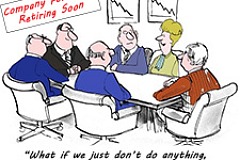 Over the next few months, we are going to give you in-depth insights and information about what determines the value of your company, what buyers look for, and advice on maximizing what your company is worth.
Over the next few months, we are going to give you in-depth insights and information about what determines the value of your company, what buyers look for, and advice on maximizing what your company is worth.
We’ll cover one or more of the following value drivers in each edition so be sure to read the series, you and your financial advisor will be glad you did.
- Discretionary Expenses Can Obscure the True Value of a Company
- Customer Concentration
- Customer Relationships
- Family Members
- Financial Ratios
- Product and Industry Concentrations
- Train Tracks
- Real Estate Leases
- Enhance the Presentation
- Curb Appeal
- Being #1 “What does your company do?”
- Brain Drain
- 2nd Tier Management
Discretionary Expenses Can Obscure the True Value of a Company
What’s in it for me? From GE and HP to the local entrepreneur, [quotesright]every buyer of every business asks: If I buy this business, take it over, and run it well, what is in it for me? [/quotesright]
While there are often many answers to this question depending on the individual business, one area of chief concern among all businesses is profitability. For many closely held businesses certain expenses, which are discretionary or unnecessary, [quotes]even if totally legal, can obscure true profitability.[/quotes]
A few examples:
- A business owner regularly attends the industry trade conference, which just happens to be in Maui in February. While this conference is probably interesting, for most owners it is the lure of Maui, not information, which is the primary reason for attendance.
- Some owners hire their children to perform a function in the business and overpay them for this service. The extra expense may be a way to save taxes, a form of estate planning or just a generous parent helping out a child. Salaries in excess of what the owner would pay a nonfamily member, or if they would even hire a person at all, is typically considered discretionary.
- Lastly, there is the appeal of an automobile provided by the corporation, for which the board generously approved the German luxury model as necessary for the image of the corporation’s executives.
In the years leading up to sale, owners should work to limit their business expenses to those that are truly operationally necessary and will likely continue post-acquisition.
[quotes]Many business owners feel when the time comes, they can go through each discretionary item with the buyer and explain them. Maybe. [/quotes] Some buyers will listen and agree, some will listen and not care about basing their decisions on financial statement data, and still others may simply move on to the next opportunity.
Further, lenders will likely not listen at all and will base their decisions on the financial statements and tax returns provided, creating a gap between price expectations and available cash at the closing.
[sidebar]
Want to Maximize the Value of Your Company?
It’s what we do. Working with Beacon and others, we’ll help you chart a course that builds your company into the vision you’ve always had and that buyers seek out.
Working alongside you with our coaching and training programs we’ll maximize the profit from your company today and grow it fast for a bigger payout tomorrow.
Let’s discuss the opportunities, contact me today: USA: 877.433.6225 feedback@focalpointcoaching.com
[/sidebar]
Customer Concentration
As your doctor will tell you, everything in moderation is OK. However, when there is too much of one thing, even the things that are good for you, problems can occur. Too much revenue from one or a small handful of customers can be too much of a good thing.
We love customers and want as much work as we can get from each one, as all profits start with revenues. [quotesright]Buyers worry about the risk they are taking[/quotesright] on when they buy a business.
One of the things they worry about deeply is an “oops” with a client, especially early on after the purchase but before they have yet developed a strong relationship and trust factor with the client. They worry that the client will leave or significantly reduce the volume of work.
They also know that customers leave in the regular course of business for all sorts of reasons outside of their control – the customer’s product mix changed, they were bought by another entity who buys product from someone else, the purchasing manager changed and now wants to give the business to his cousin, and so many more reasons.
If it is a small client that barely registers on the income statement, the business needs to learn from the mistake, work to find a new customer to replace it and move on. [quotes]However, if the “oops” or change occurred on a significant customer account,[/quotes] moving on can be difficult and the change is sometimes fatal.
Many buyers have strong opinions about the amount of business provided by one customer that crosses the risk threshold them. For some buyers the threshold is 10 percent, for others it is 20 percent, some look at the number of customers that make-up half the business’ revenues.
Almost all buyers agree that more than 30 percent of revenues from one customer raises a red flag.
[quotesright]The effect of a customer concentration on business value ranges from buyers walking away, [/quotesright] to reducing the value in their offer to account for increased risk, to the seller being required to accept an earn out based on client retention. None of these are ideal situations. In the years leading up to sale, owners can consider options to mitigate this buyer concern, including:
- Add new clients, to make each current client less important
- Show that the “large customers” are really made up of several small customers each with autonomous purchase decision making, or
- Consider buying a competitor to reduce the overall impact as a percent of sales your significant customer represents.
Planning note:
[quotesright]Buying a competitor is a very significant step but can also be a very lucrative one. [/quotesright] Consider this: Frank has a business which would normally be worth $1,000,000, however he is only getting offers in the $800,000 due to one customer accounting for 30 percent of revenues.
His competitor, who is of similar size and profitability, is in the same boat also having a significant customer. Frank buys the competitor for $800,000. A year later, Frank goes to sell his company with revenues twice as high. His largest customer is only 15 percent of revenues, not 30 percent.
The competitor’s largest customer, now part of Frank’s business, is only 15 percent too. Thus, even before economies of scale by combining the two businesses are considered, [quotes]Frank has increased the value of his business by $200,000[/quotes] and the competitor’s business by $200,000 by reducing the customer concentration risk. The $800,000 purchase of the competitor increased Frank’s net worth by $400,000 with the acquisition.
Coming Next Month: Customer Relationships and Family Members
- by Business Coach Greg DeSimone - Beacon Equity Advisors, Inc.














